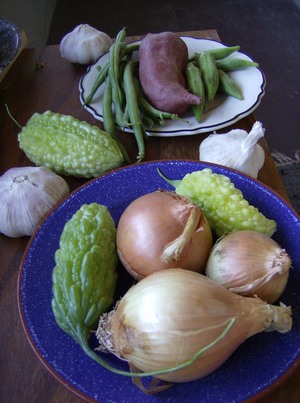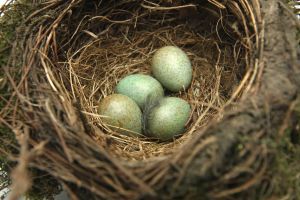People with type 2 diabetes are typically advised to exercise and to watch what they eat. Diet is a crucially important element in stabilizing blood glucose or blood sugar. Here are ten foods which research suggests may well help lower blood sugar. This information is adapted and updated from my book, Alternative Therapies for Managing Diabetes, and is followed by relevant citations.
- 1. VEGETABLES. Eating your vegetables may help people ward off diabetes. Epidemiological studies have found that vegetarians have a lower incidence of Type 2 diabetes than non-vegetarians. A 2008 study of 64,000 women in China found that the consumption of vegetables was inversely coordinated with the incidence of Type 2 diabetes, although fruit consumption was not. In this study, women who consumed the most vegetables reduced their risk of contracting diabetes by about 30 percent. Green leafy vegetables like broccoli, spinach, and Romaine lettuce are high in vitamins A, C, and K and good sources of fiber which also has a favorable effect on blood sugar.
- 2. LEGUMES. Beans, peas, peanuts and other foods that come in a pod are legumes, and they’re good for you. A study of 175 elderly men and women conducted in the Netherlands and published in the American Journal of Clinical Nutrition showed that a higher intake of legumes was inversely related to glucose intolerance, an important parameter in Type 2 diabetes.
- 3. BITTER MELON. This vegetable looks like a cucumber with warts, and it’s an Indian folk remedy for diabetes. As the name implies, bitter melon has a taste that’s a long way from sweet but it can be cooked or added to other dishes. In one study, supplements of bitter melon juice improved the glucose tolerance of 73 percent of patients with Type 2 diabetes. In another, rats with chemically-induced diabetes that were fed an extract of bitter melon for 2-4 weeks saw blood sugar levels fall to the normal range and stay low even two weeks after bitter melon supplements were stopped. Other animal studies showed normal levels of triglycerides, cholesterol, and other crucial lipids after administration of bitter melon.
- 4. CABBAGE is low in calories and high in fiber, with a glycemic index rating of near zero, meaning that it converts to sugar very slowly in the body. A 2008 study showed lower blood sugar, improved nerve cell health, and improved kidney function in rats given red cabbage daily for two months. Another study in South Korea found slightly lower blood sugar levels in rats fed high amounts of kimchee, a traditional Korean food which contains Chinese cabbage.
- 5. OKRA or gumbo is a low glycemic index food and it is low in calories. Okra contains a great deal of soluble fiber, which slows digestion of carbohydrates in the intestinal tract and can help stabilize blood sugar, according to nutritionist Sylvia W. Zook, PhD.
- 6. TUBERS such as leeks, yams, and potatoes are vegetables that grow underground. In one study, an extract of white sweet potatoes lowered the blood sugar and cholesterol in a group of subjects with type 2 diabetes. Another study in Turkey found that an oral extracts of leeks, a folk remedy for diabetes, lowered blood sugar in diabetic rats by an average of about 18 percent. An animal study published this year in India found that blood sugar and other parameters of diabetes such as serum lipid levels returned to normal after 21 days of ingesting purple yam extract.
- 7. MAITAKE. Maitake mushrooms. In one short study, two people with type 2 diabetes were given 3 caplets a day containing maitake fruit in addition to diabetes medications. Both experienced lower Hb1Ac and blood sugar readings after a few weeks taking maitake, according to a study published in Diabetic Medicine. Mice given an extract of maitake had decreased fasting blood sugar.
- 8. BREWERS’ YEAST is rich in chromium in the potent GTF form, B vitamins, and all the essential amino acids. A study in Saudi Arabia reported lower blood sugar in subjects with type 2 diabetes given brewers’ yeast, which allowed subjects to lower doses of diabetes medication. After being fed 8 grams of brewers’ yeast for two months, another study showed that 24 elderly subjects experienced improved glucose tolerance, lower cholesterol, and increased insulin sensitivity. In an animal study, diabetic nephropathy was also inhibited after the administration of brewers’ yeast.
- 9. ONIONS AND GARLIC. In an analysis of several studies published in the Journal of Medicinal Food in 2009, the blood sugar lowering effects of onion extracts on diabetic rats were found to be “significant,” although no significant effect was found for garlic. In another study, however, garlic oil supplements lowered blood sugar in men but not in women, although women showed favorable changes in cholesterol levels. In 2010, a study of diabetic rats given a garlic extract containing S-allylcysteine and saw blood sugar levels return to normal.
- 10. NOPAL. The fruit of the prickly pear cactus (minus spines and skin) is a staple of Mexican cuisine, used in dishes like huevos con nopal, carne con nopal, salads and other dishes including nopal jelly. Nopal is one of the lowest foods on the glycemic index. Several studies in Mexico have shown blood sugar lowering effects.
———
1 — “Vegetable but Not Fruit Consumption Reduces the Risk of Type 2 Diabetes in Chinese Women” The Journal of Nutrition, Vol. 138, No. 3, March 2008,
2– Am J Clin Nutr. 2008 Jan;87(1):162-7.Legume and soy food intake and the incidence of type 2 diabetes in the Shanghai Women’s Health Study.
3– Welihinda J, et al. Effect of Momordica Charantia on the Glucose Tolerance in Maturity Onset Diabetes. J Ethnopharmacol. Sep1986;17(3):277-82.
Leatherdale BA, et al. Improvement in Glucose Tolerance Due to Momordica Charantia (Karela). Br Med J. (Clin Res Ed). Jun1981;282(6279):1823-24.
4– Evidence-Based Complementary and Alternative Medicine, Volume 5 (2008), Issue 3, Pages 281-287
doi:10.1093/ecam/nem029 Red Cabbage (Brassica oleracea) Ameliorates Diabetic Nephropathy in Rat
J Med Food. 2009 Apr;12(2):292-7.Antidiabetic effect of Korean traditional Baechu (Chinese cabbage) kimchi in a type 2 diabetes model of rats.
5-Eatin’ After Eden: The Meat of the Word, by Sylvia Zook, Phd, Wheatmark Press, 2008.
6-Diabetes Care. 2004 Feb;27(2):436-40.Efficacy of Ipomoea batatas (Caiapo) on diabetes control in type 2 diabetic subjects treated with diet.
J Ethnopharmacol. 2010 Mar 24;128(2):384-9. Epub 2010 Jan 25. Hypoglycemic activity and antioxidant potential of some medicinal plants traditionally used in Turkey for diabetes.
Indian J Pharmacol. 2011 Jul;43(4):455-9.Antidiabetic activity of ethanolic extract of tubers of Dioscorea alata in alloxan induced diabetic rats.
7—Diabet Med. 2001 Dec;18(12):1010.A possible hypoglycaemic effect of maitake mushroom on Type 2 diabetic patients.
Diabetes Obes Metab.2002 Jan;4(1):43-8.Effects of a water-soluble extract of maitake mushroom on circulating glucose/insulin concentrations in KK mice.
8–Saudi Med J. 2000 Sep;21(9):831-7.The effects of inorganic chromium and brewer’s yeast supplementation on glucose tolerance, serum lipids and drug dosage in individuals with type 2 diabetes.
Diabetes,1980 Nov;29(11):919-25.Beneficial effect of chromium-rich yeast on glucose tolerance and blood lipids in elderly subjects.
J Am Soc Nephrol. 2006 Apr;17(4 Suppl 2):S127-31. Inhibition of diabetic nephropathy in rats by an oral antidiabetic material extracted from yeast.
9 J Med Food. 2009 Jun;12(3):552-60. The antidiabetic effect of onion and garlic in experimental diabetic rats: meta-analysis.
Plant Foods Hum Nutr. 2010 Dec;65(4):374-8. Beneficial effect of S-allylcysteine (SAC) on blood glucose and pancreatic antioxidant system in streptozotocin diabetic rats.
10–Arch Invest Med (Mex). 1989 Apr-Jun;20(2):197-201.[Hypoglycemic action of different doses of nopal (Opuntia streptacantha Lemaire) in patients with type II diabetes mellitus].
Arch Invest Med (Mex). 1991 Jan-Mar;22(1):51-6.Influence of nopal intake upon fasting glycemia in type II diabetics and healthy subjects.





